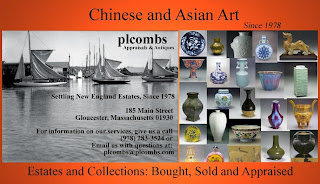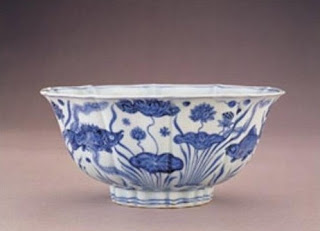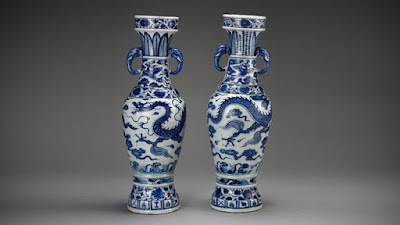Chinese Porcelain, Broken and Damaged; Fix It, Throw It Out or Use It? Estate Property,
 |
| Kangxi Yen Yen Vase |
Chinese Porcelain, Broken and Damaged
Frequently people will come across a piece of Chinese or Japanese porcelain that's been tucked away and forgotten or found while in the process of settling a family member's estate. They may even find numerous pieces around a house along with the usual bric-a-brac and inevitably some is damaged. Its can be anything from a hairline crack to being broken in half.The question is always the same, should "we throw it out, is it worth getting fixed or should we just use it." The answer is probably; No, Yes, Yes.
Over the last couple decades the prices of Chinese porcelain have changed so much that the old stock answer of "oh, just toss it in the trash" might be a mistake, it might even be a huge mistake. For example, vases that have been cut down in height (once the kiss of death for Chinese ceramics) have sold for over a million dollars and many have sold for over $100,000 if it's rare enough. Thousands have sold for over $5,000 despite varying degrees of damage.
With modern restoration techniques and more demand than supply damaged and repaired pieces have a willing an eager market awaiting them provided they are rare enough. They do not have to be million dollar pieces to have residual value if suffering from a break, crack or a missing piece. Not even close!
 |
| Ming Period Yellow Basin with Dragon in Cobalt Blue |
Where Can You Learn The Value of Your Broken Piece? (or unbroken)
Can you look it up online? No not really, while the web is full of images of Chinese porcelains, jades, silks, bronzes, scroll, carvings on Rhino horn, bamboo and dozens other things, dating them based on photos is literally impossible with any accuracy.
For example lets say you have a pretty blue and white bowl with a an old darkened crack running from the rim. You go on the web, type in "Chinese blue and white bowl" hit "search" under "Images"
 |
| plcombs, Dealers-Appraisers, Chinese Antiques |
 |
| Extremely Rare Ru Ware Song Footed Bowl, 12 th C. |
Fortunately, getting the answer can also be found using the Internet and can easily guide you in the right direction. Especially if you live in a Metropolitan area or within a couple hundred miles of one. Seeking out someone to advise you or give a no cost look is pretty much the nature of the business. SO do not be shy.
 |
| Qianlong Famille Rose Bottle Vase, 18th C. |
All of them find us on the web. So finding someone in your area should be not too difficult. Do not rely on a "non specialist", if the person you find giving the advice seems unduly vague, get someone else. When you find someone you like and is knowledgeable, ask a lot of questions...write it down! It going to be unfamiliar information and remembering it is very hard.
OK, It has value, Now What Do You Do? "Repair or not to repair, that is the question..."
After looking around and getting the information and you opt to get the item repaired you'll need to find a restorer. Ask questions, the more valuable the item is, ask more questions. Their are several levels of restoration techniques in most cases. Anywhere from "sticking it back together" to a "museum restoration" which means it gets cleaned up and made very presentable with reversible materials (my favorite) just in case later on a better techniques comes along or an full blown high end restoration where you need an x-ray machine to see the mended spot.
 |
| 18th C. Flambe Glazed Vase |
The later is by far the most expensive and also tends to scare off collectors, they will often want their own repairer/restorer to redo the previous repair. Why? I have no idea, but it happens all the time. If the piece in question has invisible repairs, they tend to shy away as they are unsure about the extent of the work previously done.
If you do not know where to find a good ceramics restorer and dealers in your area aren't familiar with one call a local musuem or historical society. Speak with whoever is involved with "Collection Conservation" for the organization. Some larger ones have their own restoration department and might take in work to make money for the museum. The MFA in Boston did this kind of thing for years, especially with Japanese screens. So ASK , it never is a bad idea to ask. Museums regardless of their focus, tend to know who can repair things locally.
If you're thinking about getting it fixed and then selling it, ask your new best friend the Asian specialist! It may not make any difference and might very well be worth more in untouched condition, despite the chunk out of it, body crack or the truncated neck.
 |
| Ming Blue and White Bowl with Fish |
If you are seeking a person near where you to advise you are and aren't having much luck, we'd be happy to try and point you in the right direction. Asian/Chinese Antiques is a pretty small universe , over the last 30 years it seems we've met most who work and live in it.
We all love what we do and most are willing to share information readily.
Feel free to email or call with any questions about your own Chinese porcelains or their values.
Thank you for visiting ~ Peter Combs


Chinese Porcelain, Broken And Damaged; Fix It, Throw It Out Or Use It? Estate Property, >>>>> Download Now
ReplyDelete>>>>> Download Full
Chinese Porcelain, Broken And Damaged; Fix It, Throw It Out Or Use It? Estate Property, >>>>> Download LINK
>>>>> Download Now
Chinese Porcelain, Broken And Damaged; Fix It, Throw It Out Or Use It? Estate Property, >>>>> Download Full
>>>>> Download LINK sU
Interesting and impressive information, definitely will be helpful for those who are looking for top tier public adjusters and related services.
ReplyDelete